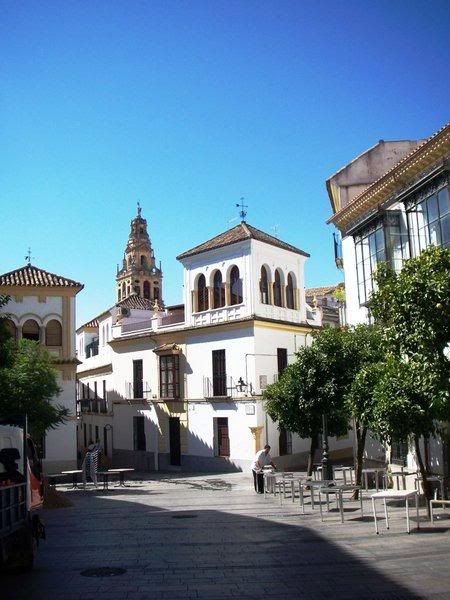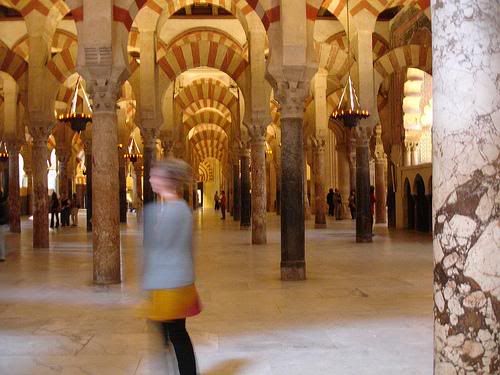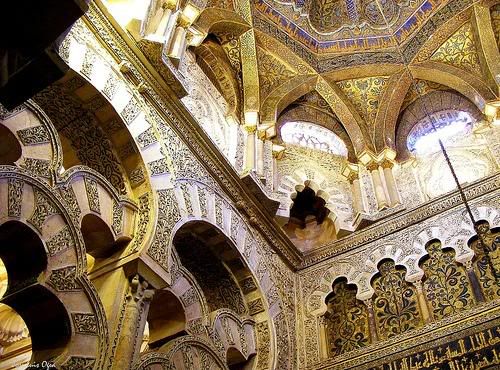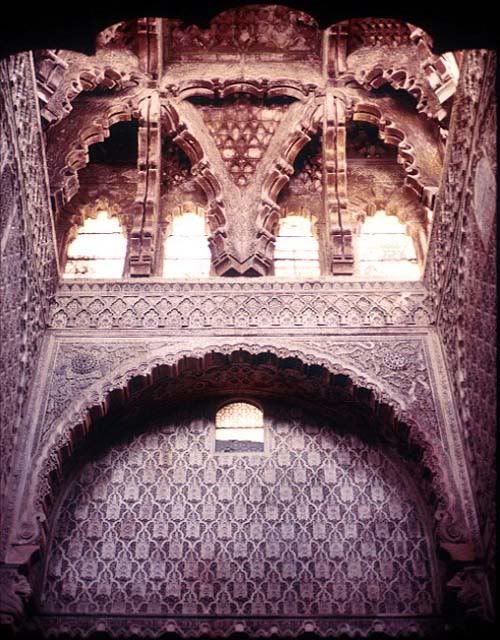|
|
Kota Alhambra ~ Cordoba ~ Andalusia... Sepanyol
[Copy link]
|
|
|
Sinar Islam kembali bercahaya di bumi Andalus.... (3)

Masjid - dari arah kawasan kota lama.
[quote]Pembukaan Masjid Jami |
|
|
|
|
|
|
|
|
|
|
|
Sinar Islam kembali bercahaya di bumi Andalus.... (4)

[quote]Ruang dewan solat di dalamnya di bina mihrab yang menyerupai mihrab Masjid Agung Cordoba yang kini telah bertukar menjadi gereja besar. Ukiran kalimah ayat suci al-Quran di atas panel kayu cedar (sejenis pohon) yang berasal dari Gunung Atlas menghiasi dewan solat masjid.
Terdapat juga jubin marmar disalut dengan pelbagai warna yang sama seperti yang terdapat di Masjid Al-Aqsa, Baitulmaqdis. Tingkap kiblat adalah replika daripada Masjid Biru di Istanbul manakala air pancut yang berada di halaman dalam bersebelahan dengan dewan solat dibina oleh pakar pertukangan dari Fez, Maghribi menurut seni reka bentuk Andalus yang diasaskan ribuan tahun silam.
Menara masjid yang digunakan oleh Muazin untuk melaungkan azan lima kali sehari dibina mengikut seni bina asli Albaicin. Di bawah cucur atap menara tertera tulisan kufi tentang deklarasi syahadah umat Islam iaitu 慣iada Tuhan selain Allah dan Muhammad adalah Rasulullah |
|
|
|
|
|
|
|
|
|
|
|
Sinar Islam kembali bercahaya di bumi Andalus.... (5)

[quote]Walaupun penulis berasa kagum dengan seni bina Masjid Jami |
|
|
|
|
|
|
|
|
|
|
|
best tul gambar2 dlm ni...terang dan jelas~
ni leh buat buku nih... |
|
|
|
|
|
|
|
|
|
|
|
The mosque's hypostyle plan, consisting of a rectangular prayer hall and an enclosed courtyard, followed a tradition established in the Umayyad and Abbasid mosques of Syria and Iraq. However, the dramatic articulation of the interior of the prayer hall was unprecedented. The system of columns supporting double arcades of piers and arches with alternating red and white voussoirs is an unusual treatment that, structurally, combined striking visual effect with the practical advantage of providing greater height within the hall. Alternating red and white voussoirs are associated with Umayyad monuments such as the Great Mosque of Damascus and the Dome of the Rock. Their use in the Great Mosque of Cordoba manages to create a stunningly original visual composition even as it emphasises 'Abd al-Rahman's connection to the established Umayyad tradition.
[ Last edited by lizz_7777 at 22-10-2008 07:14 PM ] |
|
|
|
|
|
|
|
|
|
|
|
[ Last edited by lizz_7777 at 22-10-2008 07:30 PM ] |
|
|
|
|
|
|
|
|
|
|
|
|
Interior view of the maqsura, diagonal view looking southeast down qibla wall. Mihrab is seen at center.
Interior view of the maqsura; door to the right (west) of mihrab, or Bab al-Amir
Interior view of the maqsura; ribbed vault before door to the right (west) of mihrab (Bab al-Amir)
The most lavish interior ornament is concentrated in the maqsura, the prayer space reserved for the ruler, which was commissioned by the caliph al-Hakam II. The maqsura is visually separated from the rest of the prayer hall by screens formed of elaborate intersecting polylobed arcades, an elegant variation on the basic architectural theme set in the earliest incarnation of the mosque. These screens emphasise the special status of the space, which is composed of three domed bays in front of the mihrab. The mihrab was unprecedented for taking the form of an entire room rather than the traditional niche, and for being flanked by two rooms whose entrances are decorated with mosaics in a manner similar to that of the mihrab. The maqsura is lavishly decorated with carved marble, stucco, and elaborate mosaics. These, executed in intricate vegetal scroll forms and Kufic inscriptions, frame the mihrab, the two doors which flank it, and also cover the interiors of the maqsura's three domes. The unusual arrangement of the maqsura space may be read on several levels. It may reflect the appropriation of a tri-apsidal arrangement found in local church architecture (though emptied in its new context of Christian connotations). It has also been interpreted as an ideologically charged iconographic evocation of the Mosque of the Prophet in Medina that served to underscore notions of Umayyad religious and political authority.
[ Last edited by lizz_7777 at 22-10-2008 08:40 PM ] |
|
|
|
|
|
|
|
|
|
|
|
Interior view of the sixteenth century chapel, showing Gothic vault carried on Umayyad arches

Interior view of the Royal Chapel (Capilla Real), showing zone of transition with ribbed vault Interior view of the Villaviciosa Chapel (Capilla Villaviciosa), polylobed arches along wall
After conquering Cordoba in 1236, Ferdinand III king of Castile consecrated the Great Mosque as the city's cathedral. The Christian population of Cordoba used the former mosque with relatively minor changes for the next three hundred years. In the early 16th century the Bishop and Canons of the cathedral proposed the construction of a new cathedral, and proposed to demolish the mosque in order to build it. The opposition of the townspeople to the proposed destruction of the building led to the unprecedented decision, endorsed by the Holy Roman Emperor Charles V, to insert an entire Gothic "chapel" into the very heart of the former Great Mosque. The result is an uneasy and controversiol juxtaposition: the soaring forms of a Gothic cathedral rise from the very centre of the comparatively low, sprawling prayer hall whose architectural vocabulary is rooted in the forms of classical antiquity.
Sources:
Creswell, K.A.C.1989. "The Great Mosque of Cordova." A short account of early Muslim architecture, revised edition by James W. Allan. Aldershot: Scolar Press.
Dodds, Jerrilynn. 1992. "The Great Mosque of Cordoba." al-Andalus : the art of Islamic Spain. Edited by Jerrilynn D. Dodds. New York: Abrams,11-26.
Ettinghausen, Richard and Oleg Grabar. 1987. The Art and Architecture of Islam: 650-1250. London and N.Y.: Penguin, 127-140.
Khoury, Nuha. 1996. "The meaning of the Great Mosque of Cordoba in the tenth century. " Muqarnas 13, 80-98.
[ Last edited by lizz_7777 at 22-10-2008 07:46 PM ] |
|
|
|
|
|
|
|
|
|
|
|
|
tak silap aku aku ada baca artikel kat majalah tentang Tuan Guru Nik Aziz dibenarkan sembahyang kat Masjid ini ntah aku tak pastilah... |
|
|
|
|
|
|
|
|
|
|
|
aku suka perkataan2 yg yg digunakan kat sini
codoba/cordova
al-hambra
andalusia
granada
mcm ada something dgn perkataan2 ni..
apa pun, tak pernah melawat sana lagi. tgu turn nak kesana lak, bila duit sudah byk |
|
|
|
|
|
|
|
|
|
|
|
Reply #53 silver_nano59's post
...hakikatnya, di sinilah pernah terbinanya sebuah negara Islam terkuat di dunia.
Rupa-rupanya ada kisah yang menarik dan pahit terhadap umat Islam di sini. Mungkin ramai yang tak tahu atau menyedarinya, namun inilah hakikatnya...citer lebih lanjut pada nota yg dicopy |
|
|
|
|
|
|
|
|
|
|
|
Reply #45 thessailly's post
makasih..sharing is caring konsepnyer...:handshake:
Ikutkan fakta sebenar"... Pengaruh Islam dan Arab memang kuat terhadap tamadun dunia. Malah orang Islam di Andalus telah mengeluarkan Eropah dari Zaman Kegelapan" dan Islam juga mewarisi tradisi ilmu Yunani.
Justeru...kisah Clash of Civilizations hanya satu khayalan Huttington dan Lewis yang mabuk dengan idea-idea besar, kerana kalau dikaji, rumpun tamadun Kristian/Yahudi/Islam sama.
Kalau adapun perbezaan ketara antara tamadun dunia, mungkin di antara tamadun Cina/Jepun dengan tamadun semitik. Itu pun, pergeseran tak mungkin berlaku kecuali jika ada perebutan kuasa kerana tamadun Jepun dan China adalah jenis yang eksklusif, iaitu ia tidak diperkembangkan luar dari kelompok...



The narrow pedestrian street, Calderia Nueva, was lined with Moroccan tea houses where you could drink tea and smoke a hookah, Lebanese, Moroccan, and Syrian restaurants, and shops selling spices, Middle Eastern food products, and the ubiquitous lanterns, pointy shoes and belly dancing gear. Still, it was all fascinating to us..
[ Last edited by anakencana at 23-10-2008 05:24 PM ] |
|
|
|
|
|
|
|
|
|
|
|
|
bukankah di alhamra ni juga bermula kisah Isabella ? |
|
|
|
|
|
|
|
|
|
| |
|